25.11.2021
Speech Co-Shapes the New Social Sculpture of Patras
Εικαστικες Τεχνες
Γλώσσα πρωτότυπου κειμένου: Αγγλικά
An essay by Georgia Manolopoulou about the interdisciplinary research project “TELL ME” by Yorgos Maraziotis
What are those voices behind the isolated post-industrial buildings at the heart of the urban network of Patras? Which is that liberating creative speech that depicts the productive and lively activity?
The architectural and industrial shells of this city are seeking their own voice — their “speech” — their re-use within an artistic dialogue with the city and its people that shaped them. Which, one may wonder, can be the reason that structures both the notions and the accounts of the nowadays inert city?
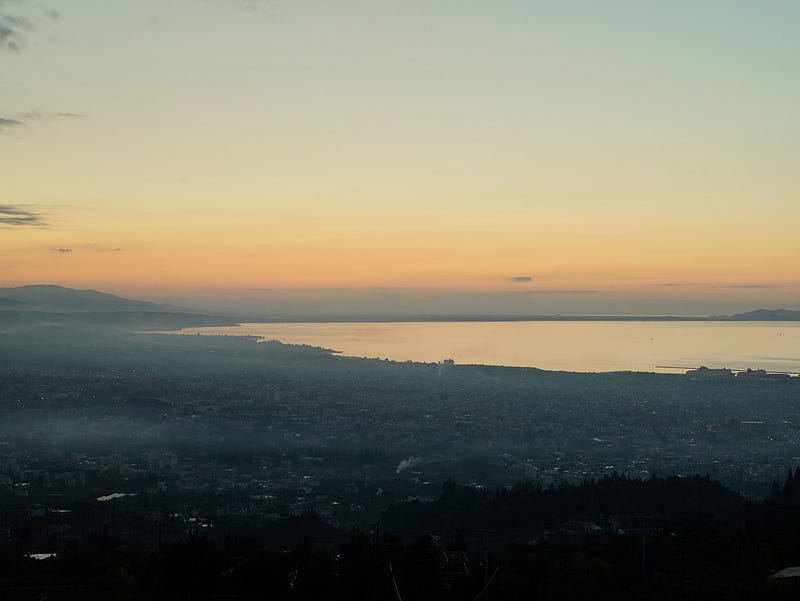
Social sculpture
The interdisciplinary research project TELL ME is making an attempt to provide an account and — both artistically and in a semiotic way — overturn the post-industrial landscape of Patras by recalling and converting individual and collective memories which have shaped the modern city. Through the creation of a contemporary type of sculpting by the artist Yorgos Maraziotis, the co-formation of a new artistic imprint in terms of “social” sculpture including as mediums the notion of speech, the human being, as well as the dynamic of expression and the individual and collective memory, under the shell of the public open space. The purpose of the social sculpture is not only to condense the speech within the material but also the transcendentalism of abstract thought aiming at an optical comprehension of values — mainly of experiences and emotions of a productive generation: that of Patras in recent times. It is an artistic intervention in the city from a different perspective — both artistically and in terms of research — which has nothing to do with that of mere compilation, citation and presentation of material documentation but it is connected — through its reference — with the sphere of the immaterial such as the oral speech. This is an account of stories whose target is to activate critical thought, emotional charge and social reinforcement.
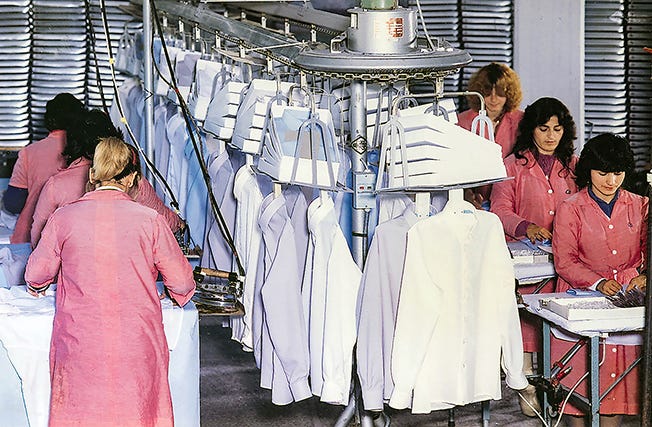
Is it, perhaps, viable and realistic to talk about artistic composition, exhibition, interpretation and version of immaterial documents through innovative artistic forms within the architectural shell?
The desire of the project team, under the inspiration and guidance of the artist Yorgos Maraziotis himself, is precisely this: the lively and illuminating representation of language through contemporary materials that may take by surprise and cause a turmoil in a pleasant and unexpected way, to the visitors of Patras through unusual and unknown streaks. The objective is the activation of the mind along with the sensitisation of emotions.
The incorporation of art within its everyday dimension
The experiences and life memories of the workers of the BESO soap and oil factories, the Mills of Saint George, the Skiadaresis company of Turkish delights, the Municipal Carnival workshop and other units of production are all at the very heart of the TELL ME multidisciplinary project. Their speech is thus materialised into a bright artistic sight within the central urban network depicting, in this way, their own personal sensitivities along with their own visual experience. At the same time, there is an attempt to project the identity of a certain community in terms of their work accompanied by particular accounts within a free, open and unbound dialogue. The voices of the factories, the human dimension of the landscapes of the city’s past productive process acquire, as it were, sound and light: that sound and light of the artistic vision and the upheaval of the public space in the city. And, as the artist himself mentions, the project upon discussion “will be viewed as a post-industrial portrait of the city in its making’’. The idea is to create artistic interventions which will render the memory and the oblivion of a post-industrial city — now seeking its past and future — to its local, cultural dynamic.
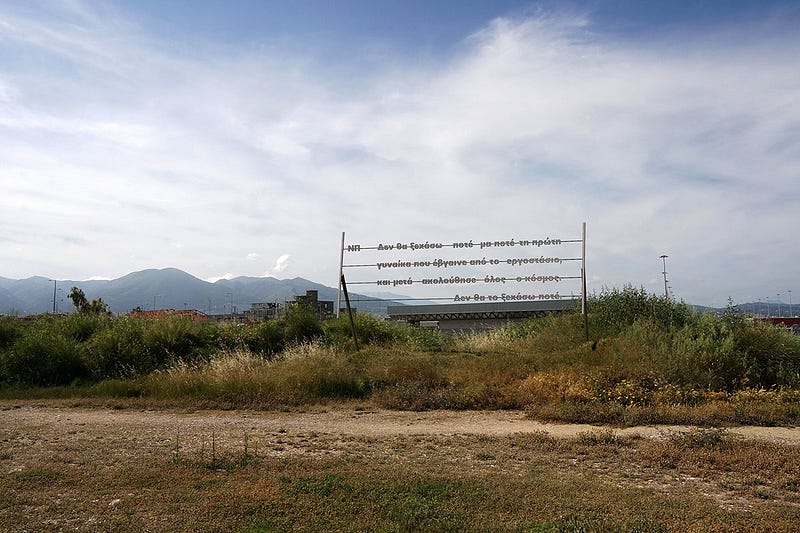
Public sculpture is inextricably influenced by the notions of space, individual and collective memory as well as the emotional charge which is diffused in the social landscape of the city. Nowadays more than ever, art is called upon to actively participate in the recreation of cities through an aesthetic reformation and, thus, reassuming its supervising role as a defining factor towards the formation of the identity of the citizen of the world. Art, with its holistic interventions — either artistic or sculptural concepts — is bound to be out there: in buildings, in public squares, in schools. It has to become a part of everyday life within our indifferent cities entailing a range of individual and collective memories or creating new, contemporary accounts or simply creating the long-desired euphoria. Not only artists but also the cultural society of the citizens in total are morally bound to promote the meaning of the city as a living cell, both in terms of memory and as an open-air museum where people and public exhibits will interact on a daily basis.
Art does have a unique way to intervene, overturn, co-shape and to structure the innate human tendency towards beauty, according to Joseph Beuys¹. Social sculpture, from my own point of view, is exactly that human-centred, moving power of art to sculpt, to aesthetically break our individual and public genetic material using noble chromosomes which carry cells of cultural intelligence. In this way, it enhances the character of art through an intense positive sign and reinforces notions and values such as aesthetics, solidarity, consciousness, acceptance of the different, responsibility, creation of cultural education as well as social awareness. After all, is it not true that those are the very values that strengthen the role of a society including a healthy democratic state?
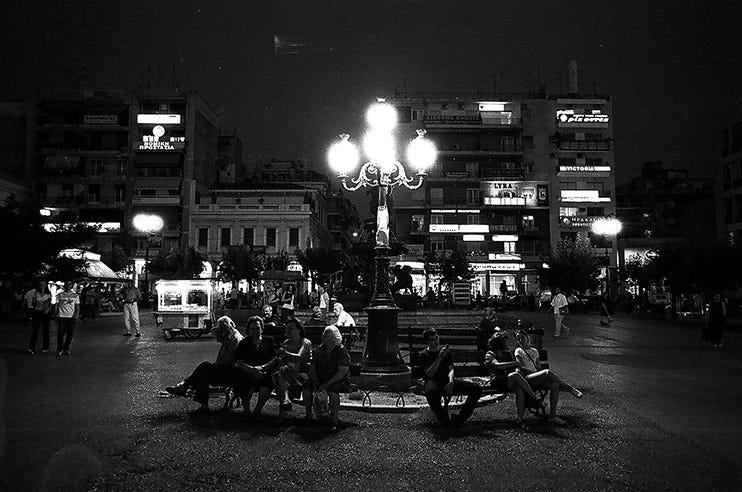
One such excellent example is that of the Greek artists of the Hellenic Diaspora², who managed to leave their own unique artistic imprint in the contemporary “social” sculpture within the public space of France under the value code: “Art as a public good”. Art comprises a dynamic agent of messages, values and symbols which embody human experience and feed our everyday life. It is a source of creation of social capital in terms of political, social and cultural intelligence that, under the present circumstances, is bound to stand out as a definitive factor for social cohesion, harmonious co-existence and dialogue as well as create a psychic euphoria which will, thus, teach cultural multiformity and democracy within the terrain of public sphere.
The peripatetic dialogues
TELL ME is based, to a great extent, on field research, experiential dimension in relation to the structure of the buildings, architectural interventions as well as the possibilities of both exploitation and activation of the “secret spots” of the selected units, as the artist himself mentions, according to his initial proposed concept. In addition, the peripatetic dialogues, the planning of special routes covering both the past and present entrepreneurial activity of the city, the study of sources, the interviews held with the working community, the documentation, the bibliographical endoscopy along with other multiple informal discussions with people of the city who are well acquainted with the artist himself, all gave life to the project as a whole. The project was also empowered by visits at the Press Museum of the Union of Daily Newspaper Editors of Peloponnesus, Epirus and the Ionian Islands, the Chamber of Commerce, the House of Kostis Palamas, and the Labour Union of Patras. Moreover, a certain part of the research was dedicated to the development of the themes under discussion as well as to the discovery of additional records in order to reveal both immaterial and material documentation which will structure speech and will transform it into an artwork.
The peripatetic dialogues held at public places in the city — especially during a difficult period, in the middle of a pandemic — functioned in a redeeming and creative way for all the collaborators of the project. After all, according to Aristotle’s Poetics our natural community is the city; it’s unique objective is its wellbeing, its interaction along with its social cohesion: an ultimate ideal for a good life. The total should always precede its part. Today’s Patras, having as a compass its rich cultural heritage and an intense contemporary activity within all forms of art does have all those promising options and perspectives at its disposal. The challenges are endless.
Patras, our city, is a restless, impatient and enthusiastic city. It is a creative place, a unique meeting point where East meets West. These are elements which are engraved in the genetic code of everyone whom the city’s womb accommodate. The capital of Western Greece traces its identity through the passage of centuries and claims its position, that belongs to the modern framework of social and cultural making. The city of Patras is considered as the economic, commercial and cultural centre of Western Greece, with direct access to the West, as its port lies at a pivotal point in relation to other European ports. Due to this fact the city has been inhabited since the prehistoric times and already enjoyed a great boom during the Mycenaean period, reaching its glorious peak in the Roman times, as it was a Roman colony, and was thus transformed into a cosmopolitan centre with an economic and cultural development. Patras has always been a centre with a multinational character and a huge commercial and cultural activity. Its significant geographic position as a gate from East to West has definitely determined the city’s history.
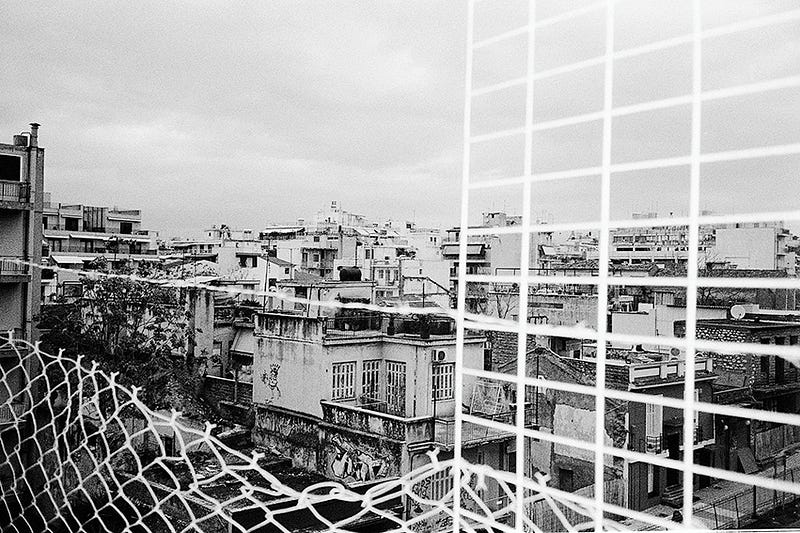
However, Patras has not limited itself within the influential bounds of its geographical position including its open-hearted landscape and its atmospheric aura but, mainly, focused on the action and coherence of its social network. The existence of social cohesion for many years along with the creation of strongly populated communities with an international feature have both functioned successfully in the city for a very long time. During the 19th and at the beginning of 20th century, Patras, once more, finds itself taking the booming lead. It is a continuously changing topos, an urban centre where historical, social and economic changes take place because of the special circumstances of this time period.
The upgrading of its port due to the enormous exports of black currants to Mediterranean destinations along with a great industrial activity that was accompanied by neoclassicism — the dominant architectural feature for the erection of public, private and religious buildings for many years — blew a fresh air to the city. Most of its inhabitants came, apart from the indigenous population, mainly from Eptanisa, from the provinces of the Ottoman Empire such as Epirus, Chios, Constantinople, Smyrna, Crete, as well as from the communities of the Diaspora: Livorno, Trieste and Vienna. At the same time, there was a settlement of investors and grand traders, in the city of Patras, who came from England, Germany, Italy, and who took charge of the industrialisation of the city. Thus there is a creation of a multicultural urban centre, a small mosaic-work of cultures, language and religion with the inhabitants being the small tesserae.
The city-port of Patras follows a full-scale development in terms of industry. The city constitutes, above all, an important transporting and commercial centre because it is the gate of the country to Europe by means of its port as there is a considerable amount of importing and exporting products. This economic prosperity contributed towards the physiognomic change of the city, the industrial activity development, the social life and the creation of a newly-formed urban class: a cosmopolitan city, in an attempt to align the local market with that of the rest of the world. Bavarian, Danish and Greek architects and urban planners (Zilller, Hansen or Kleanthis Voulgaris among others), according to the vision of Governor Kapodistrias, will take over the construction of the urban network of the centre following the Western-European schemes.
The researcher of the industrial history of Patras, Nikos Sarafopoulos, characteristically mentions in his pivotal publication, Historical Album of the Industry in Achaia 1825–1975, that the history of Achaia is interwoven with economic and productive activity. The golden age of Patras is the period 1840–1940. Several years later large units operate with great prosperity until their final cessation. Today in Achaia and the wider region of Western Greece there is an optimistic dimension, that of growth, innovation and recent business activity, which is now evolving through start-ups with the parallel training of young people in mediums of healthy entrepreneur venture having culture as a developmental tool. The cultural industry is an important part of the scheme in the area. And as the drafting of a new development strategy in the field of culture has an international character, it is now considered imperative the need to formulate a new cultural strategy in the city of Patras, in order for it to respond culturally and at the same time developmentally to this new era. With two poles; the purely humanitarian, in order to contribute to the cultivation of creativity, critical ability, aesthetics and sensitivity, but also the purely productive, creating pillars of economic prosperity.
TELL ME artistic research project coincided, in terms of time, with the important European initiative: New European Bauhaus³. A creative, interdisciplinary platform which began in January 2021 and whose target is to create new meeting points as well as to design future ways and attitudes of public and private life with the co-existence of art, architectural culture, social inclusion, science and innovation. It is a unique chance for the collective attempt to encourage us to imagine and build a future that will be viable without exclusions, adopting creativity within our everyday life.
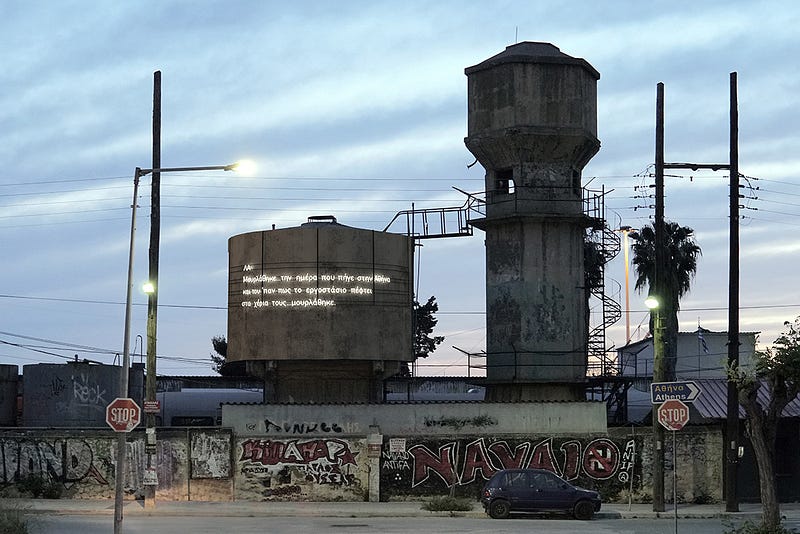
Our city includes a great number of buildings which are an integral part of its historical heritage in terms of both architecture and art. The list of such constructions may include monumental complexes or representative industrial units, which have retained important features within their architectural and structural design. In the context of a successful strategic policy — with reference to the projection of their cultural value, the diachronic course of the city and not excluding modern creation — there could be a series of initiatives being under way in order for the citizens to become acquainted with their relatively recent past but also contemporary present. We envision a “rebirth” of abandoned historic buildings through their holistic redesign, but also of the public urban fabric, with contemporary artistic installations and interventions, along with the creation of a new cultural structure; a center for contemporary art in our city.
Let TELL ME become the starting point of a dynamic initiative in Patras in order to overturn and sculpt its architectural and anthropological relief with modern and lively stories in the way they deserve to be told | tellme.
Yorgos Maraziotis is a visual artist and SNF ARTWORKS Fellow (2020). His multidisciplinary practice focuses on conceptual processes that translate visual languages through mediums such as dialogue, oral histories and common materials of the plastic arts. His artworks often gain a sensorial narrative and attempt to co-exist strong antithetical notions, such as private-public, pleasure-discontent, danger-safety. TELL ME is the multidisciplinary project by the artist Yorgos Maraziotis that studies the notion of oral history as a medium for understanding domesticity and public space. www.tellmepatras.com. | www.soundcloud.com/tellmepatras
Georgia Manolopoulou is a PhD Cand. in Cultural Diplomacy, Department of Political Science and International Relationships at the University of Peloponnese. During the last ten years she has been working at the Hellenic Ministry of Culture as a curator of Public Engagement at the Archaeological Museum of Patras. She is an owner of Scholarship IKY / Grundtvig European Program at the University of Manchester Museum and a Fellow of the NEON Curatorial Program in London. She is an author of published international papers and articles in conferences related to Cultural Management and Diplomacy, an elected member of the board of DIAZOMA and a council member of ENA Europeana. She holds a B.Sc. in Philosophy at the University of Athens and she is actively engaged in Cultural Management through her working experience in the Ministry of Culture and via an MA followed at the University of Athens.
¹ Beuys, Joseph. Social Sculpture, Invisible Sculpture, Alternative Society, Free International University. Gerpinnes: Éditions Tandem, 1988
² https://www.hellenicdiaspora.org/home/documentaries/
³ https://europa.eu/new-european-bauhaus/about/about-initiative_en



